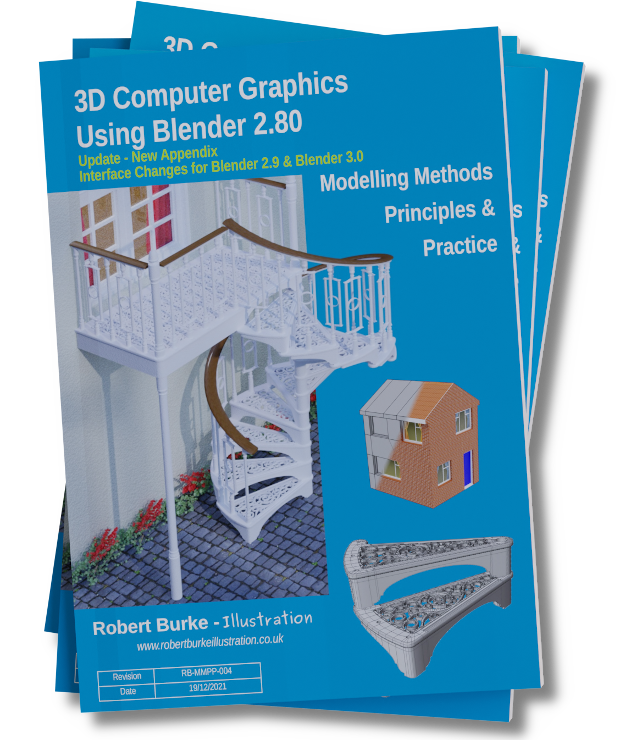Book
3D Computer Graphics Using Blender 2.80 - Modelling Methods, Principles & Practice
Update: New Appendix 5 "Interface changes between
Blender 2.8, Blender 2.9 and Blender 3.0"
These extra pages will give the reader an understanding of what to look out for when following the book using Blender 2.9 and Blender 3.
Having used Blender for around 17 years Robert has amassed a great deal of experience creating illustrations, product visualisations and training animations. In 2007 he released a series of structured tutorials culminating in the 150 page PDF book “Blender Precision Modelling Guide”. The Guide detailed how to use Blenders 3D engine to produce dimensionally accurate models. This was based on Principles carried over from his 2D and 3D CAD design experience. The tutorials and Precision Modelling Guide was extremely well received by the blender community and over the years since its publication, the guide has been downloaded many hundreds of thousands if not millions of times.
This new book was initially started in 2012 for Blender 2.6x series but due to other work commitments never got past setting up the initial structure of the book. The book Modelling Methods Principles and Practice using Blender 2.80 provides both a reference to the use of many of Blenders modelling tools and practical exercises demonstrating the use of the tools.
The intention of the book is to take a new or intermediate user and give them a reference that explains what Blenders tools do. Following the reference chapters are a range of simple to intermediate practical exercises explained in detail and illustrated with step by step images as the models progress. This isn't just a click this button to achieve this result, but explains both the design intent, and the reasoning behind why and how the chosen tools are used. The final aim of the book is to give the reader sufficient knowledge and experience to be confident in the construction of their own 3D models.
The Book contains:
Pages: 522
Images: 937
Format: .pdf
Pages: 522
Images: 937
Format: .pdf
Chapter Contents
Chapter 1: Basic Concepts of 3D Computer Modelling
This Chapter looks at traditional two dimensional art, both conventional and computer drawing. Two dimensional artwork uses visual tricks to give the perception of three dimensions. The Chapter then explores the principles and benefits of creating art in a virtual three dimensional world and how coordinates are used to locate objects and define shapes within the computer.
Pages: 29 Images: 18

Chapter 2: Getting Started With Blender 2.80
Gives an overview of the different areas you see when you first open Blender and explains some of the principles and methods of using Blenders unique program layout.
Pages: 13 Images: 52
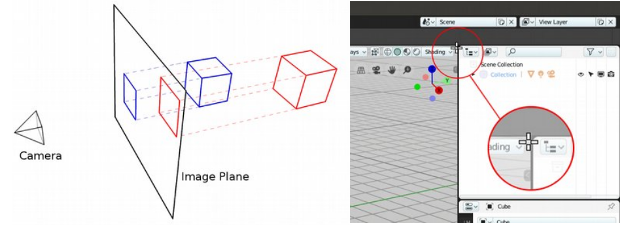
Chapter 3: Working In Object Mode
Blender contains different modes of operation and in this chapter the book shows you how objects are added to a scene and how they can be moved around and organised. The chapter provides a reference to the use of many of the tools and principles used when in Object Mode.
Pages: 25 Images: 54

Chapter 4: Mesh Modelling In Edit Mode
This is the main reference chapter for many of the tools used for creating 3D mesh models, here we look at how the tools are used and what effect the various settings and modes have on the output of the tools.
Pages: 50 Images: 119

Low-poly House Model
The first of the practical exercises is the construction of a simple low-poly house model. The process of modelling the house is explained in Chapter 5. Starting from the default cube and adding cuts, insets and faces to give the general shape for the roof and window openings. Each step of the process is described in detail along with corresponding pictures showing each change to the model.



As the book and your experience progresses we add Materials to the house in Chapter 10 and in Chapter 11 the house is UV Unwrapped. Image textures are created using the UV Map as a reference which add the colour and bump detail to the surface of the model.
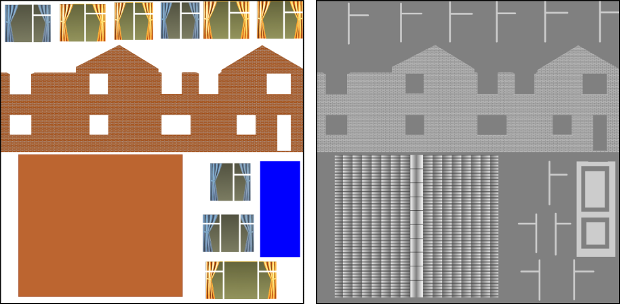
The finished model contains only 304 vertices, yet shows detailed brickwork and roof tiles.
Chapter 5: Mesh Modelling – Practice
As the book is primarily aimed at 3D modelling, this is by far the largest chapter with 90 pages of detailed explanation of the mesh modelling process. Not only are the construction of the models explained in detail, but first the design reasoning behind why the modelling tools were chosen and details on planning the modelling process.
The practical guidance for mesh modelling uses two projects to demonstrate the use of the various tools, a basic low‑poly house and a detailed Spiral Staircase. The projects follow through the various chapters of the book, so as you progress through the book, you learn about Materials, Textures, Lighting, Rendering and Animation. The introductory chapters to Materials,Textures, Lighting, Rendering and Animation gives a brief outline to their Principles and then demonstrated by applying them to the models you have created.
Pages: 90 Images: 200

Chapter 6 - Modelling With Curves, Surfaces & Text
Curves differ significantly to mesh models, however they have a distinct advantage when creating certain types of shapes. As the name implies they are ideal for the creation of curved organic shapes. This chapter is the reference to using the various types of curve objects found in Blender and explains how the different curve types are used in the construction of a model.
Pages: 26 Images: 60

Chapter 7: Modelling With Curves – Practice
For a practical demonstration of curves we add to the collection of components used for the Spiral Staircase by creating a decorative tread plate with Victorian iron scrollwork. A new project is also started to model a Stafford (Staffordshire) Knot, showing how curves can be used to create ropes and cables.
Pages: 13 Images: 23

Chapter 8: Modifiers – Reference
Modifiers are used to non-destructively alter a model and once mastered will provide a very efficient means of quickly creating models. The use and operation of many of the commonly used Modifiers associated with modelling are described in this chapter.
Pages: 42 Images: 81

Chapter 9: Modifiers – Practice
We continue with the Spiral Staircase model by using modifiers to assemble the components we have already created in Chapter 5 and 7 into the spiral staircase form. Other components to complete the staircase are then made using meshes and modifiers. The Stafford Knot has the rope detail added by arraying a mesh shaped as the profile of the rope along the Stafford Knot curve.
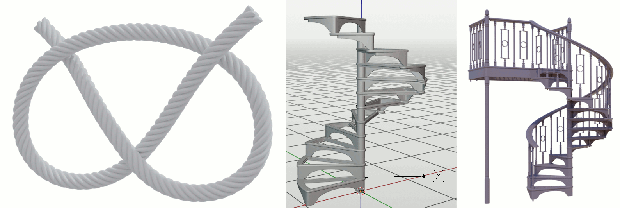 From version RB-MMPP-001b this chapter has been extended to include a section on efficient modelling with modifiers. The initial aim of the book was to introduce the reader to the core modelling tools needed to build a surface mesh. This new section extends on this looking at the different thought process needed to model non-destructively with the Boolean Modifier, and looks at avoiding some of pitfalls that can often cause the Boolean operation to fail
From version RB-MMPP-001b this chapter has been extended to include a section on efficient modelling with modifiers. The initial aim of the book was to introduce the reader to the core modelling tools needed to build a surface mesh. This new section extends on this looking at the different thought process needed to model non-destructively with the Boolean Modifier, and looks at avoiding some of pitfalls that can often cause the Boolean operation to fail

Pages: 82 Images: 169
Chapter 10: Materials – Introduction
This is an introduction to materials and includes adding different materials to different areas of a mesh and creating basic materials using nodes in the Shader Editor. The practical exercises are continued by changing the materials colour on different areas of the house model and using procedural textures to create a rough painted cast iron texture for the spiral staircase model.
Pages: 17 Images: 30

Chapter 11: Image Textures – Introduction
We look at the methods and tools used to unwrap a model to create a UV Map and then use the UV Map to create colour and bump textures. The colour and bump textures are then applied back onto the model. In the practical exercise we unwrap the house model and create colour and bump textures to give fine detail to the faces of the model, without the overhead of creating more vertices and faces.
Pages: 23 Images: 38

Chapter 12: Lighting & the World– Introduction
The introduction to lighting looks at various methods of setting up world lighting for the 3D environment, including sky shaders and High Dynamic Range Images used as HDRI Environment maps. The setup of local lighting looks at the range of Blenders lights including mesh lights, light textures and volume effects.
Pages: 13 Images: 20

Chapter 13 Rendering & Output – Introduction
An explanation of View Layers, and the settings needed to output the cameras view of the 3D scene as an image are explained in this chapter. In the practical exercise a scene is created for the Spiral Staircase in order to render out a finished image of the Spiral Staircase set against an external wall.
Pages: 18 Images: 25
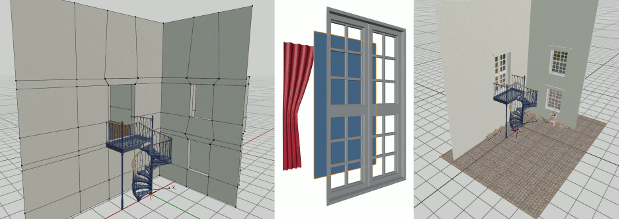
Chapter 14: Animation – Introduction
A quick look at the principles of animation is followed by setting up a short camera fly through animation of the spiral staircase scene. The results of the animation render are a series of images which are brought together in Blenders Video Editor to create the final video file. In order to speed up the rendering of the video frames a number of changes are made to the material settings so the ultra fast Eevee render engine can be used.
Pages: 18 Images: 51

Appendices
The new Appendix 5 shows the small interface changes that have been made between Blender 2.8, Blender 2.9 and Blender 3. These extra seven pages will give the reader an understanding of what to look out for when following the book using Blender 2.9 and Blender 3.
- Appendix 1: File Manager
- Appendix 2: Preferences Window
- Appendix 3: Add-ons
- Appendix 4: Links
- Appendix 5: Interface changes between Blender 2.8, Blender 2.9 and Blender 3.0
- Appendix 6: Change Log
- Appendix 7: Index
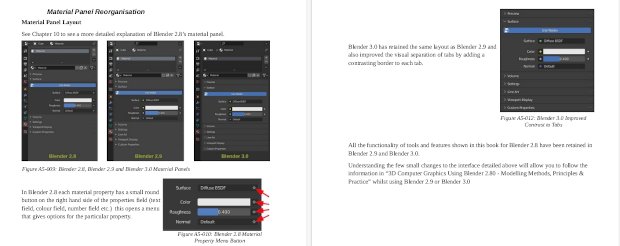
The Spiral Staircase Model
The Spiral Staircase was chosen as the main project for the book because it required a large array of Blenders tools to be used in order to construct it, making it an ideal demonstration piece. Working through the book we first make some of the basic components for the Spiral Staircase using mesh modelling principles in Chapter 5. Starting from the Circle primitive mesh, the modelling of the staircase riser is described step by step, along with the reasons why tools and modelling process was chosen. A series of images follow the models construction process.

Then in Chapter 7 an alternative more decorative tread plate is modelled using curves.

The Spiral Staircase components are assembled in Chapter 9 using modifiers and the Handrail and Balcony are modelled.
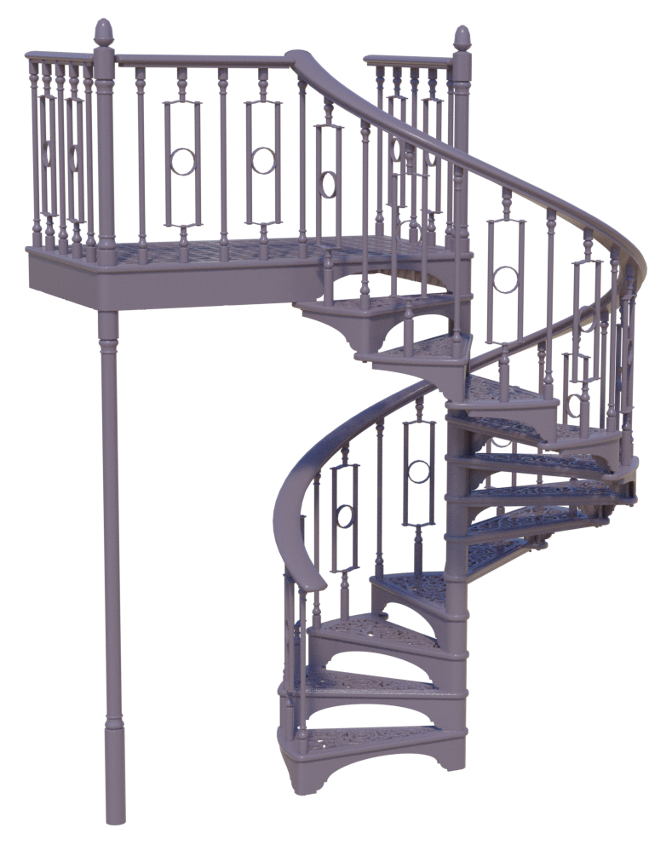
Materials and textures are added in chapter 10 and 11. A scene is constructed in Chapter 13 and an image rendered with the Spiral Staircase against a building.

A few changes to material colours and lighting effects can produce a pleasing final render.

Exclusions
This book has been written to primarily introduce readers to Blenders mesh modelling tools, which are the backbone of creating, modifying or repairing models in Blender. It has been extended to allow the practical projects to be carried through to completion by having short less detailed introductions to some of Blenders other areas such as materials, rendering animation etc. The list below details some of Blenders functions not covered in the book.
- Advanced sculpting tools and brushes
- Multi-resolution and Dynamic subdivision
- 3D painting with textured brushes and masking
- Python scripting for custom tools and add-ons
- GPU rendering
- VR rendering
- Camera and object tracking
- Rigging and animation tools
- Grease Pencil 2D Drawing
Change Log
| Date |
Revision |
Change |
| 03/09/2019 |
RB-MMPP-001a |
Added
clarifications and cleaned up typos. |
| 27/10/2019 |
RB-MMPP-001b |
Added Efficient
Modelling with Modifiers + 49 pages and 103 images |
| 15/12/2019 |
RB-MMPP-001c |
Added corrections and cleaned up typos. |
| 23/02/2020 |
RB-MMPP-002 |
Added Bevel tool
improvements to update to changes in Blender 2.82 |
| 18/06/2020 |
RB-MMPP-003 |
Changed Merge
short cut to update to changes in Blender 2.83 |
| 19/12/2021 |
RB-MMPP-004 |
Corrections, typos and a new Appendix 5 – Interface changes between
Blender 2.8, Blender 2.9 and Blender 3.0 |
Video Introduction
3D Computer Graphics Using Blender 2.80
Modelling Methods, Principles & Practice
Buy now on the secure Gumroad sales platform.
$24



